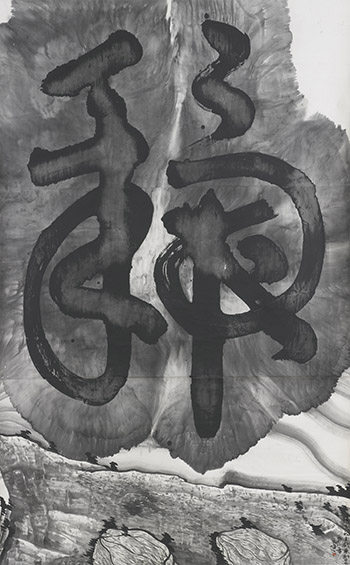EXHIBITED:
Wenda Gu: From Middle Kingdom to Biological Millennium , University of North Texas Art Gallery, Denton, Texas; H&R Block Artspace at the Kansas City Art Institute, Kansas City, Missouri; Institute of Contemporary Art at Maine College of Art, Portland, Maine, 2003-2004
Catalogue Note:
Gu Wenda is one of the most influential Chinese artists today. Like his contemporaries, Gu experienced the catastrophic Cultural Revolution, caught up with the Reform and Opening policy and encountered the floods of modernist art and philosophical thoughts. He witnessed and experienced the 85 Art Movement, and was regarded as a destructive artist. Before the critics in China showed their concerns over Chinese painting, Gu had already explored the new direction of this century-old art form. The creation of Mythos of Lost Dynasties series began as early as the 1980s and portrays the artist's innovative exploration i n art. In the early 1980s, the beauty of Chinese characters opened up a new world for Gu. Chinese characters – or to be more precise, Han characters – have played an important role in Chinese history and culture. In Han history, controlling the power of writing has always been the proud prerogative among the literate elites as well as a crucial role for the Han to assimilate the minority groups. Han characters have become incomparable writing symbols due to their deconstructive features and distinctive formation, possessessing both sounds and shapes. Over the long history of the development of Han characters, scholars have striven to study and research the changes of fonts. As a result, during the anti-tradition art trend in the mid-1980s, it was expected to see works that criticized and even opposed Han characters. Because of his experiences in writing posters during the Cultural Revolution, studying Chinese calligraphy at graduate school and reading Western philosophies, Gu was able to discover a space outside the existing meanings of Chinese characters. Among those discoveries, the recreations of seal script have been the center of his artistic creation over the years. Seal script is an official script from ancient China that preserves many pictograms. Because people found it difficult to write and recognize seal script, it was gradually replaced by other writing styles. To Gu, the inexplicableness of seal script allowed more room for imagination. He re-created seal script, forcing the meaning of the characters to be dissolved while the pictographic function of those characters make them look familiar, and there began to form a delicate and tricky connection between the works and the viewers. In his works Mythos of Lost Dynasties, the pseudo seal script created by Gu was always the center of his paintings, abruptly protruding from the void ink wash background with powerful visual impacts. The r e-constructed, meaningless characters question the authority of the traditional characters. From a different angle, the Chinese also asked the question about the inheritance of traditional culture in the new art trend. Critic Huang Zhuan once commented on Gu’s artistic achievements, saying, His status in the history of contemporary Chinese art was grounded on his two tasks: the comprehensive criticisms and continuous artistic experiments on his native culture and Western culture. The critical reconstruction of Chinese native culture was the point of departure and the core content of his tasks.
